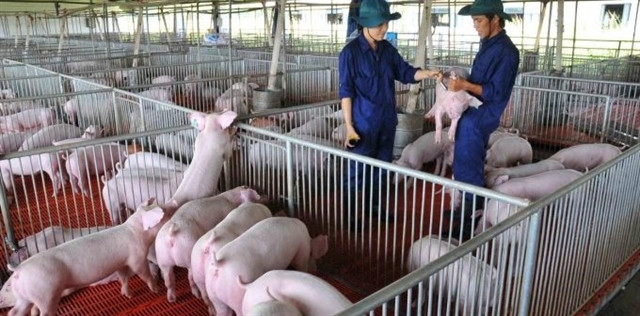 Many large enterprises have invested in the development of animal husbandry production and food processing chains. (Photo: cucchannuoi.gov.vn)
Many large enterprises have invested in the development of animal husbandry production and food processing chains. (Photo: cucchannuoi.gov.vn)After the Tet (Lunar NewYear) holiday, many animal feed products have seen a new price increasedue to the impact of the higher world price of raw materials for animal feedproduction compared to the end of 2021.
Specifically, the price has increased by about 22 percent for soybean oil, 21 percentfor soybeans, 16 percent for soybean meal and 9 percent for corn.
The main reason is due to the influence of adverse weather in the main growingareas in South American countries which provide a large volume of raw materialsfor feed production in the world.
Transportation costs are also constantly increasing because of petrol and oilprice hikes. In addition, the conflict between Russia and Ukraine is having agreat impact on corn and wheat prices at home and abroad.
The most favoured nation (MFN) tariff for some imported animal feed productshas been reduced from the end of 2021 such as from 3 percent to zero for wheatand from 5 percent to 2 percent for corn.
However, the cost of animal feed accounts for 65-70 percent of the productioncost in the livestock sector. Therefore, the record increase of those prices ofanimal feed materials has caused huge difficulties and challenges for thedomestic livestock industry, especially pig farming.
“With the price of raw materials for animal feed production increasing from2021 to now, the prices of finished animal feed products have risen by 18-22 percent.The increase in animal feed prices has made the profit of farmers plummet, andeven some households and farms suffer losses," said Tong Xuan Chinh, anofficial from Ministry of Agriculture and Rural Development (MARD).
Reducing the animal feed prices by 3 percent could make the livestockproduction cost fall by 2 percent, according to Chinh who is deputy director ofthe MARD's Livestock Production Department.
At a recent conference on solutions for developing sustainable pig productionand the management of animal feed production and trade held by MARD,experts said the reduction of import tax on animal feed is only an immediatesolution. Production of raw materials at home is a long-term solution for thedomestic livestock industry.
Local enterprises in the livestock industry are encouraged to invest inthe application of high technology and biotechnology to quickly producechemicals and biological products as raw materials for pig feed. Those productswould replace natural animal feed sources and imports. Besides that, they needto make efficient use of locally available raw materials.
However, Duong Tat Thang, director of the Livestock Production Department, saidthe livestock industry lacks efficient cooperation and livestock productionchains.
“The industry mainly has small-scale livestock production and the developmentof professional and modern production processes is limited," Thangsaid.
There is a lack of market information and forecasting so most farmers are stillpassive and dependent on traders and the intermediary stage, he said.
On the other hand, Vietnam has signed 17 free trade agreements, including newgeneration trade agreements such as the CPTTP and EVFTA or bilateral agreementswith many countries with advanced livestock production.
Therefore, it will be more difficult for domestic livestock products, includingpork products, because Vietnam is forced to open its market for foodimported from the US, Brazil, Russia, India and Germany. Domestic products,therefore, face strong competition with imported goods.
However, according to the MARD, Vietnam’s pig industry has a large consumptionmarket with nearly 100 million people and 15-18 million tourists per year thatcould increase in the coming years. In addition, mainland China, HongKong, Taiwan and Malaysia are potential import markets for Vietnam’s porkproducts.
So far, Vietnam’s livestock sector has contributed 25.2 percent ofGDP to the agricultural sector.
More and more Vietnamese and foreign enterprises haveinvested in the development of animal husbandry production and foodprocessing chains, including Masan, Dabaco, Tan Long, Truong Hai, Hoa Phat, CP,Deheus and Japfacomfeed./




























